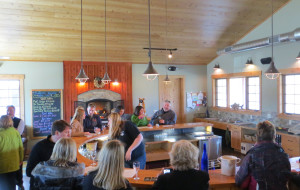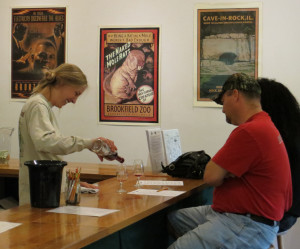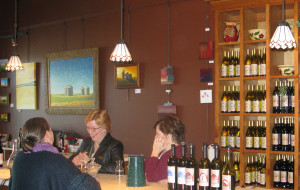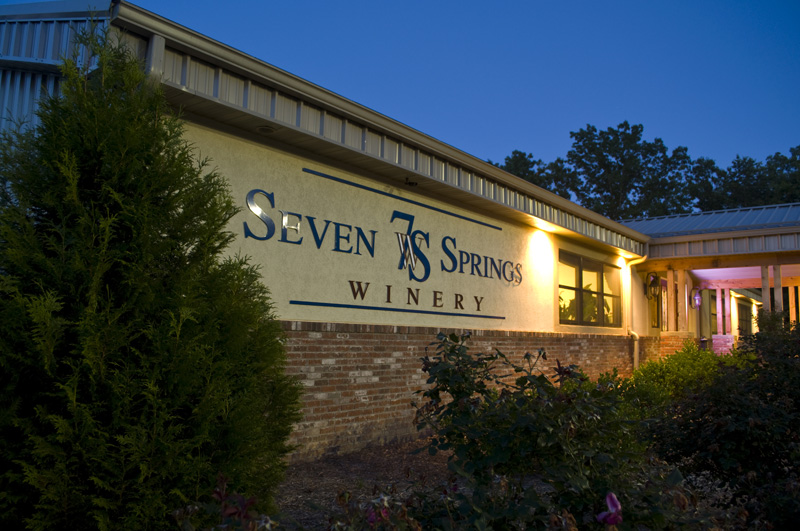Managing the Tasting Room Experience
In many cases, customers form perceptions about a winery based on their experience in the tasting room. Generally, these attitudes are based on both the interactions with the server and their perception of wine ‘quality.’

Boathouse Vineyards in Lake Leelanau, Michigan designed a circular tasing room bar with extra space for employees to service multiple customers.
Winery customers eat with their eyes. This visual process begins in the parking lot when customers first experience the visual appeal of an elaborate building. While the premise adds validity and bolsters excitement, the effects of the investment in the façade do not necessarily result in repeat sales. After all, many patrons will not re-visit a beautiful winery if they felt mistreated by the staff or disliked the wine.
Tasting room servers are a significant component of the winery experience. Please note that in the first paragraph, ‘wine servers’ are listed before ‘wine quality’ as factors affecting customer experience. As a winemaking consultant, I acknowledge the effect of tasting room servers, but maintain a belief that wine quality is paramount. However, my resolve to this ideal has weakened as I gain experience.
After all, if success is truly based on wine quality, then the natural outcome would be a shift of market share to the best wineries while the low-performers continually lose customers. Yet, most aficionados recognize that there are poor producers. Some go out of business; some experience minimal growth; some fail to overcome ‘boutique’ status despite their best efforts.
However, many continue to sell wine and maintain relevance. In these instances of ‘low quality’ wine, it may be deduced that tasting room servers are a significant component of the operation’s success. As mentioned in my previous Midwest Wine Press column, wine ‘quality’ has squishy boundaries; wines generally seem to taste better when the consumer is having a great experience.
See related story: Top Tasting Room Articles
One of the fastest, and most affordable, ways to increase revenue is to sell more wine to existing tasting room customers. Many companies recognize that it is much more expensive to acquire new customers than to maintain existing customers. As such, consider some goals that are part of recognizing the outcome of increased sales:
1) Exceed Customer Expectations. ‘Meeting customer expectations” is like saying ‘defect-free wine:” it is a low performance indicator. The mission of hospitality is to anticipate the customers’ needs. Accomplishing this mission may be recognized by the symptoms of (1) customers never have to ask for anything and (2) customers do not realize the exceptional service provided.
The tasting room staff has limited ability to develop the business culture required to consistently exceed customer expectations. This mission is deeply rooted in the policies defining how customers are treated. Sometimes, these policies require tasting room staff to say ‘no’ to customers: no more than 5 tasting samples; no winery tours; no tastings after 4:30. While great hospitality can go unnoticed and does not necessarily increase sales, a lack of hospitality does lose potential sales.

Becky Schneider, assistant winemaker at Pomona winery on the Shawnee Hills Wine Trail, enjoys enteracting with customers
2) Hire the ‘right’ employees. Much like ‘wine quality,’ the ‘right hire’ is not easily defined but readily recognized. Luckily, wine expertise can be developed through training. As such, the hiring process can focus on candidates with the skills required to provide customer service: outgoing, positive, willing to listen to customers.
3) Manage the Tasting Room Staff. When the initial excitement of working in a winery wears off, servers face the reality of the environment. Tasting room work is highly emotional, the hours are atypical and the job can become tedious. Servers also can have few growth options in the winery. This can result in dampened spirits and increased turnover. Managing the tasting room in a manner that provides professional growth and financial promotion helps motivate and retain accomplished employees. Basing promotions on the level of service provided or customer evaluations ensures payroll is being leveraged to provide the highest level of service. The by-product is content employees. Content tasting room servers may not increase tasting room sales, but seemingly ‘worn-out’ employees do lose potential sales.
4) Avoid Reducing Tasting Room Staff. There is often an ebb and flow in the volume of tasting room traffic. This pattern results in staff down time followed by a surge of work. Customer opinions are formed during the traffic surges. These opinions turn negative when guests have to wait (for anything), are refused adequate attention, or feel crowded. so plan for the traffic surge; not the slow times. Slow times can be filled with various tasks such as writing hand-written notes to case club members, input of information into the customer database, or mopping the floor. (Exceptional productivity can be recognized at the mere mention of winery floor mopping). Scheduling staff so there is an adequate number of servers during the busiest times can pay dividends in the long run.
5) Develop a Knowledgeable Tasting Room Staff. I shuddered recently when I heard a speaker at a wine conference suggest that tasting room staff needs to be friendly, but not knowledgeable. Truly, many customers are not searching for an enological dissertation. However, cases of wine don’t sell themselves. Acquiring increased sales requires time and rapport building to gain the confidence and willingness of customers. Knowledge alone may not be enough to increase sales, but a lack of knowledge is nearly guaranteed to negatively affect rapport building which does effect sales.

Like many Midwestern winery owners, Ilene Lande of Brick Arch Winery in Iowa, is actively involved in tasting room training and management
6) Teach the Tasting Room Staff to Sell. I completed an advanced degree in college, yet I never took a class about sales. Selling is the lifeblood of capitalism and, like most skills, it is not innate. New hires generally adopt successful sales strategies within a couple months, but many sales are lost in the learning process. Successful sales approaches can be as simple as: “purchase three more bottles you will be eligible for the case discount” or “what wines would you like to take with you today?”
Every winery wants to sell more wine. Generally, ‘quality’ is an integral component of an operation’s approach to increase sales. A broader definition of ‘quality’ ensures excellence permeates the entire business and establishes a culture prepared to recognize increased sales. In turn, the winery is positioned to set goals which are required to recognize the outcome of increased sales. A fast and affordable method to increase sales is to focus on selling more wine to existing customers in the tasting room.
Paul Gospodarczyk, is a Certified Sommelier based in Chicago and Director of Today’s Wine Professional at www.todayswineprofessional.com.





Paul,
Great article on tasting room management. Should be required reading for all tasting room management and principals.